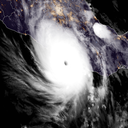Study proposes adding a Category 6 to the hurricane scale due to climate change

Hurricanes are getting so strong in a warming world that a Category 6 intensity should be added to the Saffir-Simpson Hurricane Wind scale, a new study finds.
Why it matters: The research shows how significantly climate change is altering storm intensity and other characteristics, as well as further underscoring the limitations of the scale.
Reality check: The paper, published Monday in the journal Proceedings of the National Academy of Sciences, does not represent an official move by the National Hurricane Center to add another hurricane category.
- Instead, it offers scientific reasons for the new category to be considered.
- The researchers note that the top hurricane category — Category 5 — has no upper bound, despite the fact that the damage potential from such a storm's maximum sustained winds increases exponentially.
The intrigue: The study comes as scientists are having to add new classifications and colors to marine heat stress maps, and alter axes on charts of ocean heat content and other climate variables as rapid, human-caused climate change brings large shifts around the globe.
- Last year was the warmest since instrument records began and very likely the hottest in at least 125,000 years.
- This year is expected to come near to or beat the record set in 2023.
- Early data shows January was likely the 9th-straight-hottest month.
Zoom in: Climate change increases ocean and air temperatures, along with atmospheric water vapor.
- Tropical cyclones tap into the energy from these sources to form and intensify.
- The greater amount of hurricane fuel in a warming world is already causing these storms to change in multiple ways that can make them more destructive, the study shows, relying on growing scientific evidence.
Between the lines: Studies have shown that by increasing ocean and air temperatures, climate change is causing tropical cyclones to become wetter, and to undergo faster and more frequent bouts of rapid intensification.
- There is also evidence of an increase in the proportion of storms that reach higher storm categories.
What they found: The study defines a hypothetical Category 6 for hurricanes, with maximum sustained winds of greater than 192 mph.
- It shows that a number of recent tropical cyclones would meet that criteria.
- These include Super Typhoon Haiyan, which devastated the Philippines in 2013, Hurricane Patricia in 2015, and Super Typhoon Meranti.
- It also finds that human-caused climate change has more than doubled the risk of Category 6-strength storms since 1979, by investigating shifts in a metric called potential intensity.
Yes, but: There are many shortcomings of the Saffir-Simpson Scale, chief among them that it only focuses on wind when most hurricane-related fatalities are caused by water.
- Still, the study states the category addition would "raise awareness about the perils of the increased risk of major tropical cyclones due to global warming."
What they're saying: "For more than 35 years we have expected to see increases in the thermodynamic speed limit for hurricane winds and now we are seeing this increase in both climate analyses and models," meteorologist Kerry Emanuel, told Axios via email.
- "Observations of actual hurricanes show that the percentage of storms reaching high intensity has been increasing,"
- Gabriel Vecchi, a climate scientist at Princeton University, told Axios via email: "I think the paper is correct that more and more storms are so far away from the beginning of the Cat. 5 range that it makes sense to perhaps say they are of a different category."
- "And it's true that we expect more and more of these super-Cat 5 events as [the] climate warms."
- However, Vecchi, along with three other outside hurricane experts Axios contacted, said they ultimately favor reforming the existing scale to incorporate water and other hazards, or doing away with it altogether.
The bottom line: The study does not defend the Saffir-Simpson Scale, however. Instead, it points to another way it falls short.
- "We are only pointing out that as a wind-only-based measure of risk, climate change is making it progressively inadequate," said co-author Jim Kossin of First Street Foundation and the University of Wisconsin.